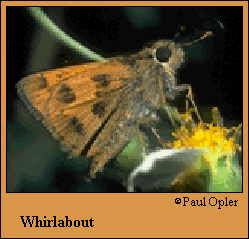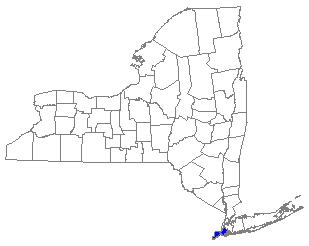 |
 

 |



Whirlabout (Polites vibex [Geyer])
Wing span: 1 - 1 1/2 inches (2.5 - 3.9 cm).
Identification: Males and females are very different. Male: Upperside is yellow-orange; forewing has a black stigma and neighboring black square patch; black margins of hindwing are smooth inwardly. Underside is yellow-orange; hindwing has a few large blurred black spots. Female: Upperside is dark brown; forewing has a few clear spots. Underside is gray or sooty yellow with a central pale patch outlined with dark scales.
Life history: Adult flight is quick and darting. Females are usually found in forest openings or edges; males perch to await females during the afternoon. Caterpillars live in a tube of silked-together leaves and feed mostly at night.
Flight: Two broods from April-September in the north; all year in Florida and South Texas.
Caterpillar hosts: Grasses including Bermuda grass (Cynodon dactylon), St. Augustine grass (Stenotaphrum secundatum), and thin paspalum (Paspalum setaceum).
Adult food: Nectar from flowers including shepherd's needle and lantana.
Habitat: Scrubby or open habitats including dunes, fields, pinewoods, roadsides, forest openings, yards, and parks.
Range: Southeastern United States and the West Indies south through eastern Mexico and central America to Argentina. Periodically strays north to northeast Iowa, northern Ohio, and Connecticut.
Conservation: Not required.
The Nature Conservancy Global Rank: G5 - Demonstrably secure globally, though it may be quite rare in parts of its range, especially at the periphery.
Management needs: None reported.
References:
Opler, P. A. and G. O. Krizek. 1984. Butterflies east of the Great Plains. Johns
Hopkins University Press, Baltimore. 294 pages, 54 color plates.
Opler, P. A. and V. Malikul. 1992. A field guide to eastern butterflies. Peterson
field guide #4. Houghton-Mifflin Co., Boston. 396 pages, 48 color plates.
Scott, J. A. 1986. The butterflies of North America. Stanford University Press,
Stanford, Calif. 583 pages, 64 color plates.
Stanford, R. E. and P. A. Opler. 1993. Atlas of western USA butterflies including
adjacent parts of Canada and Mexico. Denver and Fort Collins, CO.
Tilden, J. W. 1986. A field guide to western butterflies. Houghton-Mifflin Co.,
Boston, Mass. 370 pages, 23 color plates.
Author: Jane M. Struttmann
State and Regional References:
Cech, R. 1993. A Distributional Checklist of the Butterflies and Skippers of
the New York City Area (50-mile Radius) and Long Island. New York City
Butterfly Club Special Publication. 27 pp.
Forbes, W.T.M. 1960. Lepidoptera of New York and Neighboring States. Part
IV: Agaristidae through Nymphalidae Including Butterflies. Cornell Univ.
Agricultural Experimental Station, Ithaca, N.Y. Memoir 371. 188 pp.
Glassberg, J. 1993. Butterflies Through Binoculars: A Field Guide to
Butterflies in the Boston-New York-Washington Region. Oxford Univ. Press,
New York, N.Y. 160 pp.
Klass, C. and Dirig, R. 1992. Learning about Butterflies. Cornell Cooperative
Extension Publication, 4-H Member/Leader Guide 139-M-9. Ithaca, N.Y.
36 pp.
Layberry, R.A., Hall, P.W. & Lafontaine, D.J., 1998. The Butterflies of
Canada. University of Toronto Press, Toronto, ON. 280 pp.
Opler, P.A. 1998. A field guide to eastern butterflies, revised format.
Houghton Mifflin Co., Boston.
Shapiro, A.M. 1974. Butterflies and Skippers of New York State. Cornell Univ.
Agricultural Experimental Station, Ithaca, N.Y. Search 4:1-60.

